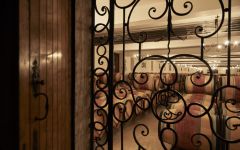Chateau Leoville Barton 2017
-
Wine
Enthusiast -
Jeb
Dunnuck -
James
Suckling -
Wine
Spectator -
Robert
Parker - Decanter



Product Details
Your Rating
Somm Note
Winemaker Notes
Intense purple color with a bright nose of blackfruit, graphite and toast. On the palate, the attack is frank and the tannins are precise and remarkably delicate. The wine develops a beautiful tension and freshness.
Professional Ratings
-
Wine Enthusiast
This boldly tannic wine has a firm structure that gives it an excellent potential. That’s because the great blackberry fruits are just as important, offering a ripe, juicy character that is already succulent and delicious. Drink this wine from 2024.
-
Jeb Dunnuck
The deep, inky-colored 2017 Léoville-Barton is a classic, powerhouse wine from this estate that’s going to need bottle age. Loads of black and blue fruits, violets, classy oak, and ample minerality all soar from the glass. It’s medium to full-bodied, concentrated, and backward on the palate. With fabulous purity and integrated acidity, forget bottles for 5-6 years and enjoy over the following two decades. The blend in 2017 is 93% Cabernet Sauvignon and 7% Merlot, harvested from the 15th to the 29th of September, and aging in 60% new French oak.
Barrel Sample: 94-96 -
James Suckling
The purity of cabernet sauvignon really comes through here with currants, blackberries and stones. Perfumed, too. Medium to full body. Very fine, polished tannins and a fresh, fruity finish. This shows a compact palate with a polished, creamy finish. Much higher percentage of cabernet than is usual. Drink after 2023.
-
Wine Spectator
Packed with ripe, lively plum, blackberry and black currant fruit, backed by melted black licorice and bramble accents throughout, this retains a sense of polish despite the energetic fruit and structure. Ends with an encore of warm plum reduction. Cabernet Sauvignon and Merlot. Best from 2023 through 2037.
-
Robert Parker's Wine Advocate
Deep garnet-purple colored, the 2017 Leoville Barton charges out of the gate with bold notions of baked plums, creme de cassis and blueberry preserves plus wafts of pencil shavings, fragrant earth and cedar chest. Medium to full-bodied, the palate delivers mouth-coating black fruit preserves with compelling herbal sparks and a firm, grainy texture, finishing long and lively.
-
Decanter
Great depth through the mid palate, and as with Poyferré there is both delicacy and finesse to the expression that suggests the style of the vintage emphasizes the classical side of St-Julien. As things open in the glass sweet black cherry with liquorice root and crushed earth comes through in the mid palate. This has poise, concentration and confidence, easily one of the best in the appellation.
Other Vintages
2022- Vinous
-
Robert
Parker -
Jeb
Dunnuck -
James
Suckling - Decanter
-
Robert
Parker -
James
Suckling - Decanter
-
Jeb
Dunnuck
-
Jeb
Dunnuck -
James
Suckling -
Wine
Spectator -
Wine
Enthusiast -
Wilfred
Wong - Decanter
-
Robert
Parker
-
Wine
Enthusiast -
Robert
Parker -
Jeb
Dunnuck -
Wine
Spectator - Decanter
-
James
Suckling
-
Jeb
Dunnuck -
Wine
Spectator -
James
Suckling -
Wine
Enthusiast - Decanter
-
Robert
Parker
-
James
Suckling -
Wine
Spectator -
Robert
Parker -
Jeb
Dunnuck -
Wine
Enthusiast - Decanter
-
Connoisseurs'
Guide
-
Jeb
Dunnuck -
Wine
Enthusiast -
James
Suckling -
Wine
Spectator -
Robert
Parker - Decanter
-
Wine
Enthusiast -
Wilfred
Wong -
James
Suckling -
Wine
Spectator -
Robert
Parker -
Jeb
Dunnuck - Decanter
-
Wine
Enthusiast -
Wine
Spectator -
Robert
Parker -
James
Suckling
-
Wine
Enthusiast -
Robert
Parker -
Wine
Spectator -
James
Suckling
-
Wine
Enthusiast -
James
Suckling - Decanter
-
Wine
Spectator -
Robert
Parker
-
Wine
Enthusiast - Decanter
-
James
Suckling -
Wine
Spectator -
Robert
Parker
-
Wine
Enthusiast -
James
Suckling -
Robert
Parker -
Connoisseurs'
Guide -
Wine
Spectator
-
Wine
Spectator -
Wine
Enthusiast -
Robert
Parker
-
Wine
Enthusiast -
James
Suckling -
Wine
Spectator -
Robert
Parker -
Connoisseurs'
Guide
-
Wine
Enthusiast -
Robert
Parker -
Wine
Spectator -
Wine &
Spirits
-
James
Suckling -
Wine
Spectator -
Jeb
Dunnuck -
Robert
Parker -
Wine
Enthusiast -
Wine &
Spirits
-
Robert
Parker
-
Robert
Parker -
Wine
Spectator
-
Wine
Spectator -
James
Suckling -
Wine
Enthusiast -
Robert
Parker -
Wine &
Spirits
-
Wine &
Spirits
-
Wine &
Spirits -
Robert
Parker -
Wine
Spectator
-
Robert
Parker -
Wine
Spectator
-
Robert
Parker -
Wine
Spectator
-
Wine
Spectator -
Robert
Parker
-
Wine
Spectator -
Robert
Parker
-
Robert
Parker -
Wine
Spectator







In 1826, Hugh Barton, already proprietor of Chateau Langoa, purchased part of the big Leoville estate. His part then became known as Léoville Barton. Six generations of Bartons have since followed, and continued to preserve the quality of the wine, classified as a Second Growth in 1855.
In 1983, Anthony Barton, the present owner, was given the property by his uncle Ronald Barton who had himself inherited it in 1929. Anthony Barton's daughter Lilian Barton Sartorius now helps her father in managing the estate. Together, they maintain the traditional methods of winemaking, producing a typical Saint-Julien of elegance and distinction. The Château Léoville Barton is the property of the Barton’s family and Lilian Barton Sartorius manages it with her two children, Mélanie and Damien.
